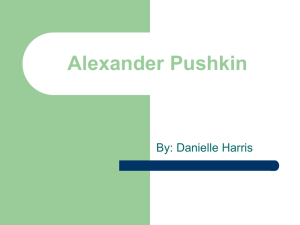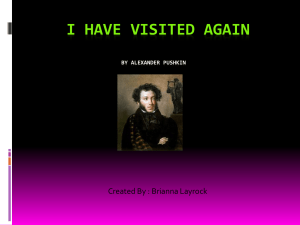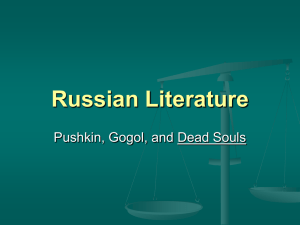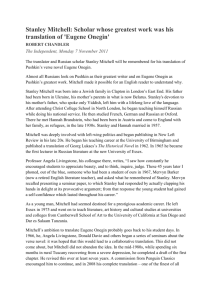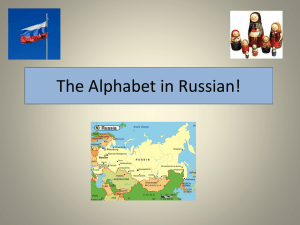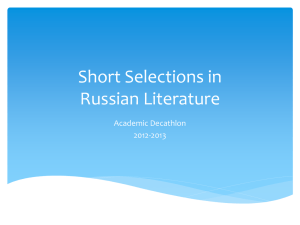Eugene Onegin
advertisement
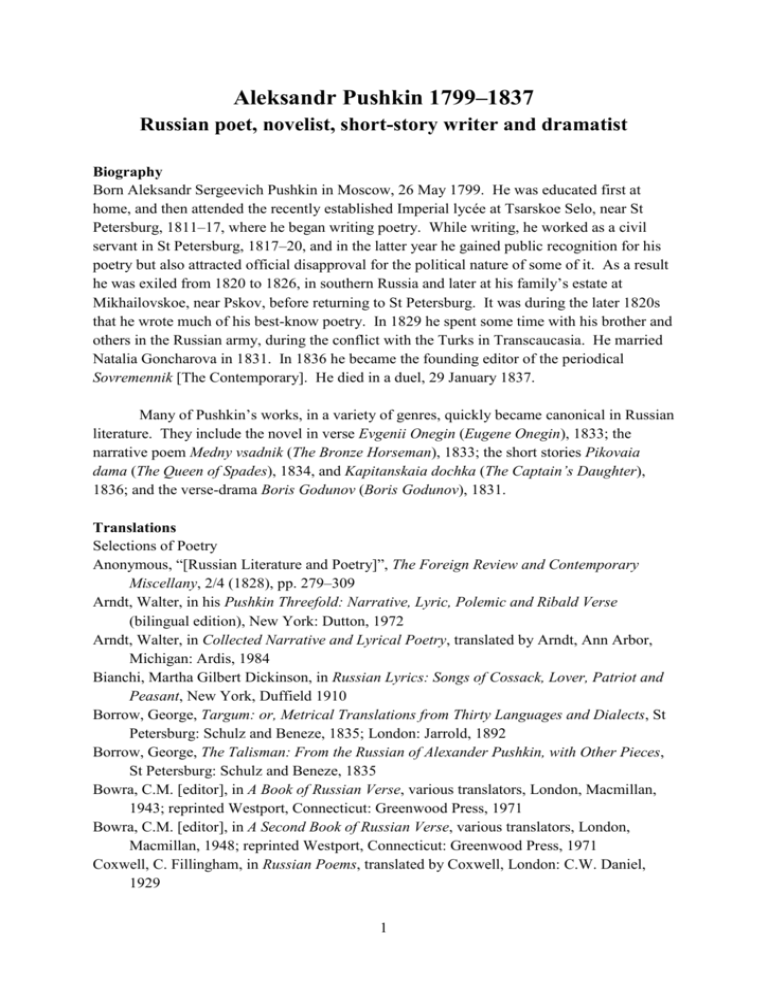
Aleksandr Pushkin 1799–1837 Russian poet, novelist, short-story writer and dramatist Biography Born Aleksandr Sergeevich Pushkin in Moscow, 26 May 1799. He was educated first at home, and then attended the recently established Imperial lycée at Tsarskoe Selo, near St Petersburg, 1811–17, where he began writing poetry. While writing, he worked as a civil servant in St Petersburg, 1817–20, and in the latter year he gained public recognition for his poetry but also attracted official disapproval for the political nature of some of it. As a result he was exiled from 1820 to 1826, in southern Russia and later at his family’s estate at Mikhailovskoe, near Pskov, before returning to St Petersburg. It was during the later 1820s that he wrote much of his best-know poetry. In 1829 he spent some time with his brother and others in the Russian army, during the conflict with the Turks in Transcaucasia. He married Natalia Goncharova in 1831. In 1836 he became the founding editor of the periodical Sovremennik [The Contemporary]. He died in a duel, 29 January 1837. Many of Pushkin’s works, in a variety of genres, quickly became canonical in Russian literature. They include the novel in verse Evgenii Onegin (Eugene Onegin), 1833; the narrative poem Medny vsadnik (The Bronze Horseman), 1833; the short stories Pikovaia dama (The Queen of Spades), 1834, and Kapitanskaia dochka (The Captain’s Daughter), 1836; and the verse-drama Boris Godunov (Boris Godunov), 1831. Translations Selections of Poetry Anonymous, “[Russian Literature and Poetry]”, The Foreign Review and Contemporary Miscellany, 2/4 (1828), pp. 279–309 Arndt, Walter, in his Pushkin Threefold: Narrative, Lyric, Polemic and Ribald Verse (bilingual edition), New York: Dutton, 1972 Arndt, Walter, in Collected Narrative and Lyrical Poetry, translated by Arndt, Ann Arbor, Michigan: Ardis, 1984 Bianchi, Martha Gilbert Dickinson, in Russian Lyrics: Songs of Cossack, Lover, Patriot and Peasant, New York, Duffield 1910 Borrow, George, Targum: or, Metrical Translations from Thirty Languages and Dialects, St Petersburg: Schulz and Beneze, 1835; London: Jarrold, 1892 Borrow, George, The Talisman: From the Russian of Alexander Pushkin, with Other Pieces, St Petersburg: Schulz and Beneze, 1835 Bowra, C.M. [editor], in A Book of Russian Verse, various translators, London, Macmillan, 1943; reprinted Westport, Connecticut: Greenwood Press, 1971 Bowra, C.M. [editor], in A Second Book of Russian Verse, various translators, London, Macmillan, 1948; reprinted Westport, Connecticut: Greenwood Press, 1971 Coxwell, C. Fillingham, in Russian Poems, translated by Coxwell, London: C.W. Daniel, 1929 1 Deutsch, Babette and Avrahm Yarmolinsky, in their Russian Poetry: An Anthology, New York: International, 1927 Elton, Oliver, in his Verse from Pushkin and Others, London: Edward Arnold, 1935 Fennell, John, in his Pushkin, Harmondsworth and Baltimore: Penguin, 1964 Gray, Mary Kremer, A Collection of Short Lyrics by Pushkin, Done into English Verse … From the Literal Translation of Ivan Bunin, Hartford, Connecticut: privately printed, 1936 Kisch, Cecil, in his The Wagon of Life and Other Lyrics by Russian Poets of the Nineteenth Century (parallel texts), New York: Oxford University Press, 1947 Nabokov, Vladimir, in his Three Russian Poets: Selections from Pushkin, Lermontov and Tyutchev, Norfolk, Connecticut: New Directions, 1944 Newmarch, Rosa, et al., in Poetry and Progress in Russia, edited by Newmarch, London and New York: John Lane, 1907 Panin, Ivan, Poems by Alexandr Pushkin, Boston: Cupples and Hurd, 1888 Pollen, John, in his Rhymes from the Russian, London: Kegan Paul Trench Trübner, 1891 Shaw, Thomas Budge, “Pushkin, the Russian Poet”, Blackwood’s Edinburgh Magazine, 57 (June 1845) pp. 657–78; 58 (July 1845) pp. 28–43; 58 (August 1845) pp.140–56 Thomas, D.M., The Bronze Horseman: Selected Poems of Alexander Pushkin, London: Secker and Warburg, and New York: Viking, 1982 Turner, Charles Edward, in his Studies in Russian Literature, London: Sampson Low, Marston Searle and Rivington, 1882 Whittaker, Cynthia H., Alexander Pushkin: Epigrams and Satirical Verse, Ann Arbor, Micigan: Ardis 1984 Wilson, C.T., in his Russian Lyrics in English Verse, London: Trübner, 1887 Yarmolinsky, Avrahm, et al., in The Poems, Prose and Plays of Alexander Pushkin, edited by Yarmolinsky, New York: Modern Library, 1936 Yarmolinsky, Avrahm (editor), in A Treasury of Russian Verse, New York: Macmillan, 1949 Narrative Poetry Tsygany, 1825–27 Arndt, Walter, The Gypsies (parallel text) in his Pushkin Threefold: Narrative, Lyric, Polemic and Ribald Verse, 1972 Borrow, George, “Song: From the Russian of Pushkin” in his Targum: or, Metrical Translations from Thirty Languages and Dialects, 1835 Bowra, C.M., “Gypsy’s Song”, in A Second Book of Russian Verse, various translators, 1948 Coxwell, C. Fillingham, The Gypsies (excerpts) in Russian Poems, translated by Coxwell, 1929 Fennell, John, The Gypsies, in his Pushkin, Harmondsworth and Baltimore: Penguin, 1964 Thomas, D.M., The Gypsies in his The Bronze Horseman: Selected Poems of Alexander Pushkin, 1982 Turner, Charles Edward, “Zemphira’s Song”, in his Studies in Russian Literature, 1882 Evgenii Onegin, 1833 See entry on Eugene Onegin, below 2 Mednyi vsadnik, 1837, written 1833 Arndt, Walter, The Bronze Horseman in his Pushkin Threefold: Narrative, Lyric, Polemic and Ribald Verse, 1972 Coxwell, C. Fillingham, The Bronze Horseman in Russian Poems, translated by Coxwell, 1929 Elton, Oliver, The Bronze Horseman in his Verse from Pushkin and Others, London: Edward Arnold, 1955 Fennell, John, The Bronze Horseman (bilingual edition) in his Pushkin, Harmondsworth and Baltimore: Penguin, 1964 Johnston, Charles, “The Bronze Horseman” in his Narrative Poems by Alexander Pushkin and Michael Lermontov, New York: Random House, 1983; London: Bodley Head, 1984 Lednicki, Waclaw, Pushkin’s Bronze Horseman: The Story of a Masterpiece, University of California Press, 1955 (includes Elton’s translation of the poem) Thomas, D.M., The Bronze Horseman in his The Bronze Horseman: Selected Poems of Alexander Pushkin, 1982 Turner, Charles Edward, The Bronze Cavalier (excerpts) in his Studies in Russian Literature, 1882 Short Story Pikovaia dama, 1834 Aitken, Gillion R., “The Queen of Spades”, in his The Complete Prose Tales of Alexandr Sergeyevitch Pushkin, London: Barrie and Rockliff, and New York: Norton, 1966 Anonymous, “The Queen of Spades”, Papers for the People, 38 (1850), Edinburgh: Chambers, pp. 1–18; reprinted in Living Age, vol. 27, Boston, E. Littell, 1850 pp. 405– 13 Bronstein, Ethel O., “The Queen of Spades” in A Treasury of Russian Literature, edited by Bernard Guilbert Guerney, New York: Vanguard Press, 1943 Chamot, A.E., “The Queen of Spades” in his Selected Russian Short Stories, London: Milford and Oxford University Press, 1925 Debreczeny, Paul, “The Queen of Spades”, in Complete Prose Fiction, edited and translated by Debreczeny, Stanford, California: Stanford University Press, 1983 Duddington, Natalie, “The Queen of Spades” in The Captain’s Daughter and Other Tales, translated by Duddington, with an introduction by Edward Garnett, New York: Viking Press, 1928; London: Dent, 1933; revised edition as The Captain’s Daughter and Other Stories, 1961 Edmonds, Rosemary, “The Queen of Spades” in The Queen of Spades, The Negro of Peter the Great, The Captain’s Daughter, translated by Edmonds, Harmondsworth: Penguin, 1962 Keane, Thomas, “The Queen of Spades” in his The Prose Tales of Alexander Poushkin, London: Bell,1894; reprinted Freeport, New York: Books for Libraries Press, 1971 3 Myers, Alan, “The Queen of Spades” in Tales of the Late Ivan Petrovich Belkin, The Queen of Spades, The Captain’s Daughter, Peter the Great’s Blackamore, with an introduction by Andrew Kahn, Oxford and New York: Oxford University Press, 1997 Nack, James, “The Queen of Spades: A Russian Legend” in The Gift of Friendship: A Token of Remembrance, for 1854, Philadelphia: Henry F. Anners, 1853, pp. 128–48 Townsend, Rochelle S., “The Queen of Spades” in Short Stories by Russian Authors, translated by Townsend, London: Dent, and New York: Dutton, 1924 Novel Kapitanskaia dochka, 1836 Aitken, Gillon R., The Captain’s Daughter in his The Complete Prose Tales of Alexandr Sergeyevitch Pushkin, 1966 Debreczeny, Paul, The Captain’s Daughter, in Complete Prose Fiction, edited and translated by Debreczeny, Stanford, California: 1983 Duddington, Natalie, The Captain’s Daughter in The Captain’s Daughter and Other Tales, translated by Duddington, 1928 Edmonds, Rosemary, The Queen of Spades, The Negro of Peter the Great, The Captain’s Daughter, translated by Edmonds, 1962 Hebbe, G.C., The Captain’s Daughter; or, The Generosity of the Russian Usurper Pugatscheff, New York: C. Müller, 1846 Keane, Thomas, The Captain’s Daughter, in his The Prose Tales of Alexander Poushkin, 1896 Myers, Alan, The Captain’s Daughter in Tales of the Late Ivan Petrovich Belkin, The Queen of Spades, The Captain’s Daughter, Peter the Great’s Blackamore, with an introduction by Andrew Kahn, Oxford and New York: Oxford University Press, 1997 Telfer (née Mouravieff), Mrs.J. Buchan, The Captain’s Daughter in her Russian Romance, London: H.S. King, 1875; reprinted New York: Island Press, 1946 Zielinska, Marie H. de, Marie: A Story of Russian Love, Chicago: Janson McClurg, 1877 Play Boris Godunov, 1841, produced 1870 Barbour, Philip L., Boris Godunov (parallel texts), New York: Columbia University Press, 1953 Dole, Nathan Haskell, Boris Godunóf (excerpts; bilingual edition) in his Pushkin, 1964 Fennell, John, Boris Godunov: A Drama in Verse, London: Kegan Paul, Trench, Trübner, and New York: Dutton, 1918 Hayes, Alfred, Boris Godunóv: A Drama in Verse, London: Kegan Paul, Trench, Trübner, and New York: Dutton, 1918 Reeve, F.D., Boris Godunov, with an introduction, in his An Anthology of Russian Plays: Volume I 1790–1899, vol. I, New York: Vintage, 1961 Turner, Charles Edward, Boris Godunoff (excerpts) in his Studies in Russian Literature; reprinted in The Drama: Its History, Literature and Influence on Civilization, edited by Alfred Bates, vol. 18, London: Athenian Society, 1903 4 Underwood, Edna Worthley, “Scene from Boris Godunof” in The Slav Anthology: Russian, Polish, Bohemian, Serbian, Croatian, Portland, Maine: Mosher Press 1931 Selected Poems The talent of Russia’s greatest poet was recognized by English-speaking critics as early as 1824 (Bowring, 1824, p. 98). Though Pushkin was too young to earn a place in Bowring’s faulty but influential anthology (Specimens of the Russian Poets, London, 1821–23), his poetry was first translated into English for an ANONYMOUS article in The Foreign Review in 1828. These short excerpts from Ruslan i Ludmila, Kavkazkii plennik and “Brat’ia razboiniki” preserve Pushkin’s meter but alter his rhyme schemes. BORROW, who worked in St Petersburg for the Bible Society from 1833 to 1835, published two small volumes in 1835 containing the first complete English translations of Pushkin texts: Targum offers “The Black Shawl” (“Chernaya shal’”) and “Song” (Zemfira’s song from Tsygany), while The Talisman presents the title work (“Talisman”) and “The Mermaid” (“Rusalka”). Borrow, a confessed emulator of Edward Fairfax in the “targumanic art”, retains Pushkin’s amphibrachic tetrameter in “The Black Shawl”, but misleadingly favours transliteration over translation when it suits the meter. (Though Pushkin and Borrow never met, the poet sent his English translator a note of thanks in 1855 for copies of Targum and The Talisman, and kept the book in his personal library.) Pushkin’s (and, elsewhere, Gogol’’s) first important champion in English was SHAW (1845), named adjunct Professor of English Literature at Pushkin’s old school — the Lycée at Tsarskoe Selo — in 1842. For his insightful, sometimes errant, article extolling Pushkin, Shaw offers complete translations of 23 poems in which the original meter and rhyme scheme are preserved, but without the monotonous metrical regularity of Borrow. In a detailed introduction to the translations, Shaw berates Bowring for “[spinning] a collection of easy rhymes”, and made the following claim for his own work: Of the poetical merit of these translations, considered as English poems, their writer has no very exalted idea; of their faithfulness as versions, on the contrary, he has so deep a conviction, that he regrets exceedingly the fact, that the universal ignorance prevailing in England of the Russian language, will prevent the possibility of that important merit — strict fidelity — being tested by the British reader. Shaw’s verse, like his critical prose, exhibits considerable sophistication, and he generally passes the test of fidelity; his renderings are easily the finest of Pushkin’s nearcontemporaries. For his appreciation of Pushkin, TURNER (English Lector in the University of St Petersburg) offers linear translations (1882), in generally accurate rhythmic prose, of two dozen or so excerpts from a wide range of genres. WILSON (1887) presents 11 metrical, rhymed translations, freely abridging originals and altering rhyming schemes and meter; his 5 English style is labored. Ivan Nikolaevich PANIN (1888), a widely published theologist, offers the first lengthy volume (179 pages) of Pushkin’s poems in English, rendering his 68 selections into painfully literal prose, often bending meanings to support his view that Pushkin was “a lyre on which … God invisibly played” (p. 19); with his contempt for critics, idiosyncratic literality, and crabbed annotations, Panin uncannily anticipates Nabokov’s approach to Evgenii Onegin some 75 years later (50 years later, GRAY (1936), with no knowledge of Russian, inconsistently versifies 24 of Panin’s renderings). POLLEN (1891) presents 10 of Pushkin’s most celebrated lyric poems, often sacrificing rhyme to achieve admirable syntactic clarity while generally maintaining Pushkin’s original meter. NEWMARCH (1907) gives seven poems (in addition to two excerpts from Evgenii Onegin) in her own translations and in versions by W.R. MORFILL and Helen FRANK; these specimens tend to preserve the original rhyme and meter, though literality is often sacrificed for the sake of natural English rhythm. As a preface to the 13 lyrics (and four Onegin excerpts) by “the great founder of Russian poetry”, BIANCHI, (1910) aided by an unnamed native speaker, falls far short of preserving the “exact rhythm” she professes to retain. DEUTSCH, a noteworthy American poet, often collaborates with Avrahm Yarmolinsky in anthologies of Russian poetry, the first of which appeared in 1921 (Modern Russian Poetry, New York: Harcourt). The expanded edition, which appeared six years later (DEUTSCH & YARMOLINSKY, 1927), contained 13 Pushkin poems in which Deutsch scrupulously sought to preserve the original rhyme scheme, meter, and test length while producing impressive alliteration and assonance, as, e.g., in “The Prophet” (“Prorok”). Her translations, which often sacrifice precise literality, are the mainstay of Yarmolinsky (1936 and 1949). YARMOLINSKY (1936), the most extensive one-volume compendium since Panin, offers 50 verse works, five of which were translated by Maurice BARING, Thomas SHAW, Max EASTMAN, Constance GARNETT, and Oliver ELTON. Of the 45 Pushkin specimens in Yarmolinsky (1949), all but one (translated by Eastman) appear in Deutsch versions. COXWELL’s 35 specimens (1929) preserve original rhyme and meter, though original paragraph- and stanza-breaks are often ignored; the sense of the original is disconcertingly distorted. Of the 12 items in ELTON (1935), only two are lyrics; the translator favors sound and structure over meaning, admires Shaw’s technical achievements (p. 22), and distorts sense and strains style in order to retain original meters and rhyme schemes. The 47 Pushkin poems in BOWRA (1943 and 1949) illustrate varying approaches of numerous translators (BOWRA, Maurice BARING, ELTON, R.M. HEWITT, Maud F. JERROLD, V. de S. PINTO, W.A. MORRISON). In NABOKOV (1944), the great prosaist and later defender of literality offers rhymed metrical translations of two lyric poems and three long pieces from Pushkin’s Malen’kie tragedii (Little Tragedies); in the lyrics, Nabokov eliminates feminine rhymes and shortens lines while retaining an impressive degree of the original meaning. KISCH (1947) presents the Russian and English in parallel, opening with 10 Pushkin lyrics in versions which adhere to the meter and rhyme scheme of the originals. 6 In the most reliable English-language edition for students of Russian, FENNELL (1964) furnishes 48 of Pushkin’s shorter poems — and six specimens of large-scale works — in plain, graceful English prose; after the fashion of The Penguin Book of Russian Verse (Harmondsworth, 1962), translations appear as non-linear blocks of prose under the Russian originals on the same page. Even more encyclopedic in approach, ARNDT (1972) offers 74 shorter poems and seven longer specimens first in rhymed, metric translations, the in a parallel section containing the Russian originals with plain prose versions opposite; in the metric translations, structural conformity to the originals is often achieved by the introduction of non-Pushkinian padding, and rhymes at times seem forced. In ARNDT (1984), the translator’s numerous rhymed, metric translations (99 shorter poems, 12 complete narrative poems, and excerpts from Onegin) are conveniently gathered together; the more obscure texts in WHITTAKER (1984) make a useful, if much more uneven, companion volume. THOMAS (1982), an accomplished British poet, adheres to no rigorous system, preferring to approximate Pushkin’s meters and rhymes only when this does not interfere with the clarity and force of the English; the 38 shorter poems and 10 complete longer items achieve a stylistic naturalness rare in translations of Pushkin. Narrative Poetry The Gypsies (Tsygany, 1824) BORROW (Targum, 1835; see above) offers the first English specimen from Tsygany: Zemfira’s song. He preserves meter, rhyme-scheme, and sense, as in the first stanza: “Hoary man, hateful man! / Gash my frame, burn my frame; / Bold I am, scoff I can / At the sword, at the flame”. A rhythmic prose translation of the same song appears in TURNER (1882). COXWELL (1929) offers four key excerpts in rhymed, metric versions, though meaning is seriously distorted. BOWRA (1948) gives only Zemfira’s song, and preserves only half the rhymes in his rather stilted English version. FENNELL (1964) furnishes a scrupulously accurate prose translation of the complete Russian text, which appears above the English on each page. A very literal, complete prose translation in ARNDT (1972) helpfully appears line-by-line in parallel with the Russian: the metric translation is typical of Arndt’s style (see above). In his fluid metric version, THOMAS (1982) abandons rhyme altogether, and effectively interpolates a modified version of BORROW’s old rendering of Zemfira’s song. The Bronze Horseman (Mednyi vsadnik, 1833) TURNER (1882) gives 85 lines of Pushkin’s narrative masterpiece in sensible, rhythmic prose. As elsewhere, COXWELL’s complete translation (1929) reproduces meter and rhymes at the expense of meaning, though this version of Mednyi vsadnik is one of the more faithful items in his Pushkin selection. ELTON’s (1935) annotated version frequently strains English style to preserve the original rhyme scheme and meter, and the original meaning is often obscured; LEDNICKI’s monograph on Mednyi vsadnik employs Elton’s translation as an appendix. FENNELL’s prose translation (1964) under the original is a model of its kind (see above). The versions in ARNDT (1972) have the virtues and vices of his other translations in 7 this collection (see above), though his rhymed, metric rendition is far more successful than ELTON. THOMAS (1982) alters Pushkin’s stanza structure and chooses blank verse to stand for the original rhymed iambic tetrameter, but the result is undeniably powerful. The rhymed, metric translation in JOHNSTON (19894) is the most successful example of this approach to Mednyi vsadnik; Johnston retains considerable line-by-line accuracy, scrupulously reproduces the original’s structure, and achieves these difficult goals in tasteful, fluid English verse. Fiction The Queen of Spades (Pikovaia dama, 1854) The first English version of Pushkin’s most popular story appeared in ANONYMOUS (1850); the original is shorn of its master epigraph and six chapter-epigraphs, and names are either transliterated or concocted (as in the nonsensical “Princess Dolgorouski” and “convent of Procashca”). None the less, this translation, though probably made from Merimée’s French version (Phelps, p. 430), is reasonably faithful and complete, and the idioms of mid-19th century English suit Pushkin’s tale well. James NACK (1853), who styles himself the story’s author, proffers a completely recast abridgement, containing new character names, redesigned incidents, and a moralistic tone and conclusion; the appalling result is more Karamzin than Pushkin. Standing above the plethora of 19th century abridgements and corruptions is KEANE, (1894) which has often been anthologized; this version is more literal and sensitive to the original than ANONYMOUS (1850), though the chapter-epigraphs are still missing and there are occasional mistranslations. TOWNSEND’s more colloquial translation (1924) still lacks epigraphs, a flaw at last corrected by CHAMOT (1925), who exactly reproduces the format of Pushkin’s original; the metric translation of the epigraph for chapter 1 impressionistically renders a thorny mixed meter, and the story’s general tone matches the detachment of the original. In her somewhat more British version, DUDDINGTON (1928) also includes all epigraphs. BRONSTEIN (1943) gives a more conversational rendering which reproduces the original’s topography, and she provides footnoted translations of the four chapter epigraphs that contain French; her verse rendering of the chapter 1 epigraph is closer to Pushkin’s original meter than Chamot, though less agile. EDMONDS (1962) is faithful to the original format and offers several useful footnotes, though her choices for English equivalents can be idiosyncratic, as in the translation of the master epigraph. AITKEN (1966) offers a generally accurate, structurally faithful translation in more modern English style. With its copious annotations and scrupulous conformity to the original, DEBRECZENY (1983) is an excellent scholarly version in graceful English; Walter Arndt furnishes the chapter 1 epigraph, and an 1819 fragment anticipating the story’s opening scene is helpfully appended. MYERS combines close adherence to Pushkin’s text, a fine introduction and notes by Andre Kahn, and a low price to make this the textbook edition of choice. 8 The Captain’s Daughter (Kapitanskaia dochka, 1836) The first English translation of Pushkin’s Scottian novel is HEBBE (1846). In her relatively complete, tersely annotated version, TELFER eliminates the master epigraph and all 14 chapter-epigraphs and preserves verse in plain prose; the style is distractingly archaic, with consistent use of forms of thee for second-person singular Russian forms nand excessive odd transliterations peppering the text (e.g. yemstchick for iamschik). The abbreviated version of ZIELINSKA (1877) is more appropriately colloquial, though the novel and one of its chapters have been retitled to emphasize the hero’s love interest (Mar’ia Ivanovna Mironova), verse passages and all epigraphs are omitted, and bizarre nicknames are interpolated. KEANE (1896) presents a complete, annotated version without the mannered style of its predecessors; verse passages receive rhymed, metrical translations, though the novel is still bereft of epigraphs. All epigraphs are included by DUDDINGTON (1928), as is Pushkin’s “omitted chapter” (an early variant of chapter 13), though character names in the latter fragment are altered to match those in Pushkin’s final version of the novel; archaism is avoided in this sparsely annotated translation, with the rhyme and meter of verse passages only occasionally preserved. EDMONDS (1958) annotates her version generously, includes all epigraphs and the “omitted chapter” (with names altered as in Duddington), and preserves meter and rhyme in the poetry specimens. The technical approach of AITKEN (1966) (format, verse renderings) is identical to that of Duddington, though the annotations are somewhat fuller and the original names in the “omitted chapter” are retained. As with Pikovaia dama, DEBRECZENY’s edition (1983) leads the field; a graceful, literal translation is supported by almost 90 authoritative notes and a faithful version of the “omitted chapter”. Thanks to Andrew Kahn’s excellent introduction and annotations, MYERS offers a version that comes close to being as attractive as DEBRECZENY. There are occasional misleading divergences from Pushkin’s original (e.g. failure to translate posazhennyi otets as “proxy father” in chapter 12, which keeps the reader from making a crucial connection back to Grinv’s dream in chapter 2), but the low price of this edition makes it a good choice for those seeking a textbook. Play Boris Godunov (Boris Godunov, 1831, produced 1870) The first English translation of Pushkin’s Shakespearean drama took the form of illustrative excerpts for critical essays on the poet. TURNER gives five or six pages of translated material, rendering Pushkin’s iambic pentameter and prose passages in rhythmic, generally accurate prose. DOLE (1889,1890) preserves the original meter and opts for archaic diction in his nearly complete presentation of Pimen and Grigorii’s scene, an extended excerpt from Dimitrii and Marina’s garden scene (“Noch’. Sad. Fontan”), and shorter excerpts from several other key scenes. The first complete English version is HAYES (1918), who provides stress for most names, favors translation over transliteration for place names, annotates untranslatable puns, furnishes a list of dramatis personae (absent in the original), and leaves macaronic passages 9 in their original languages; two scenes omitted by Pushkin from the published Russian edition are included in the main body of the play (though this is inconsistently noted). UNDERWOOD (1931) gives one excerpt — the complete text of “Noch’. Sad. Fontan”) — in iambic pentameter with slightly altered stanza structure. In his complete translation, Barbour (1953) renders verse in iambic pentameter, and provides a parallel Russian text, extensive notes (which contain English translations of the macaronic passages), dramatis personae list, and Pushkin’s “omitted” scenes; there are fewer deliberate archaisms in Barbour than in Hayes. REEVE’s literal translation (1961) into modern English makes only a casual attempt to reproduce Pushkin’s iambic pentameter, and is the first to include the original dedication to Karamzin; the “omitted” scenes are left out, and a short introduction to the play takes the place of notes. Fennell (1964) furnishes key excerpts (Boris’s monologues, “Noch’. Sad. Fontan”, Boris’s death scene, Basmanov and Pushkin at headquarters) with contextualizing explanations above a scrupulous, modern English translation. THOMAS P. HODGE Further Reading Alekseev, M.P., “Dzhon Bauring i ego ‘Rossiiskaia antologia’” and “Pushkin i angliiskie puteshestvenniki v Rossi” in Russko-angliiskie literatunye sviazi: XVIII vek-pervvaia polovina XIX veka), Literaturnoe nasledstvo, vol. 91, Moscow: Nauka, 1982 Alekseev, M.P., “Pushkin i zapad” in Pushkin i mirovaia literatura, Leningrad: Nauka, 1982 Bayley, John, “Select Bibliography” in his Pushkin: A Comparative Commentary, Cambridge: Cambridge University Press, 1971 Bowring, John, Specimens of the Russian Poets, vol. 1, 2nd edition, London: R. and A. Taylor, 1821; Boston: Cummings and Hilliard, 1822; vol. 2, London: Thomas Davison, 1823 Bowring, John, “Politics and Literature of Russia”, Westminster Review, 1/1 (January 1824) pp. 80–101 Cross, Anthony, “Early English Specimens of the Russian Poets”, Canadian-American Slavic Studies, 9/4 (Winter 1975) pp. 449–62 Feinstein, Elaine (editor), After Pushkin: Versions of the Poems of Alexander Pushkin by Contemporary Poets, with an introduction by Feinstein, Manchester: Carcanet, 1999 Kandel’, B.L., “Ukazatel’ perevodov poemy Mednyi vsadni na iazyki narodov SSSR ii inostrannye iazyki, in Mednyi vsadnik, by Pushkin, Literaturnye pamiatniki, Leningrad: Nauka, 1978 Kandel’, B.L., “Ukazatel’ perevodov romana Kapitanskaia dochka in Kapitasnskaia dochka, by Pushkin, 2nd edition, Literaturnye pamiatniki, Leningrad: Nauka, 1985 Lewanski, Richard C. (editor), The Literatures of the World in English Translation, vol. 2: The Slavic Literatures, New York Public Library / Ungar, 1967; revised 1971 Phelps, Gilbert, “The Early phases of British Interest in Russian Literature”, Slavic and East European Review, 36/87 (June 1958) pp. 418–33 Simmons, Ernest J., “Pushkin in English” in his Pushkin, Cambridge, Massachusetts: Harvard University Press, 1937 Wiener, Leo, in his Anthology of Russian Literature, part 2: The Nineteenth Century, New York: Putnam 1903, pp. 122–25 10 Yarmolinsky, Avrahm (editor), Pushkin in English: A List of Works by and about Pushkin, New York: New York Public Library, 1937 See also the translators’ introductions to Elton, Fennell, Thomas and Arndt (1984) Eugene Onegin Evgenii Onegin, 1833 Subtitled “A Novel in Verse”, containing eight chapters, 1825–31; originally published as separate chapters 1825–32, and then twice during Pushkin’s lifetime in book form: 1833 and 1837. Translations Translators have used various editions, often making comparisons between two or more versions and sometimes including passages that Pushkin ultimately rejected. During his work on the novel, Pushkin frequently altered the text, rewriting some stanzas, adding or dropping others, and even eliminating what was originally the eighth of nine chapters and aborting a tenth. The two most authoritative modern editions, the large Academy edition of 12937 and the small Academy edition of 1949, contain some differences in their efforts to arrive at a canonical text. Arndt, Wlter, Eugene Onegin, New York: Dutton 1961; revised edition, 1981 Clough, S.D.P., Pushkin’s Eugene Onegin (parallel texts), Oxford: S.D.P. Clough, 1988 (originally published by the translator in Hommage to Pushkin, Malvern, Worcestershire, 1978 and 1982) Deutsch, Babette, Eugene Onegin, in The Works of Alexander Pushkin, edited by Avrahm Yarmolinsky, New York: Random House, 1936; revised edition, Baltimore and Harmondsworth, Penguin, 1964 Elton, Oliver, Evgeny Onegin, London: Pushkin Press, 1937 Falen, James E., Eugene Onegin, Carbondale: Southern Illinois University Press, 1990; Oxford: Oxford University Press, 1995 Hofstadter, Eugene Onegin: A Novel in Verse / A Novel Versification, New York: Basic Books, 1999 Johnston, Charles, Eugene Onegin, London: privately printed, 1977; New York: Viking, 1978; revised edition, Harmondsworth: Penguin, 1979 Kayden, Eugene M., Eugene Onegin, Yellow Spriongs, Ohio: Antioch Press, 1974 Nabokov, Vladimir, Eugene Onegin, 4 vols, New York: Bollingen Foundation, and London: Routledge and Kegan Paul, 1964; revised edition, 1976, 1981 Radin, Dorothea Prall and George Z. Patrick, Eugene Onegin, Berkeley: University of California Press, and London: Cambridge University Press, 1937 Spalding, Lieutenant-Colonel Henry, Eugene Onéguine, London: Macmillan, 1881 11 Alexander Pushkin’s Eugene Onegin, subtitled “A Novel in Verse”, stands at the head of the entire 19th-century Russian literary tradition. Referred to by at least one contemporary critic as “encylopedic” on account not only of the breadth of its subject matter and allusions but also of the richness of its vocabulary (and the resulting associations, which cannot be fully duplicated in another language or at another time) as well as of its impressive variety in narrative manners and tone, the novel remains both a progenitor in terms of character types and language, as well as an outstanding achievement in its own right. Few of the masterworks in the Russian poetical tradition translate well into English, and with Onegin the problem is compounded by the formal devices that Pushkin employed to dazzling effect. The poem is written in the iambic tetrameter, the most popular verse line of Pushkin’s day, and the lines are then fitted into the so-called Onegin stanza, a 14-line unit that rhymes AbAbCCddEffEgg (where small letters small for masculine or one-syllable rhymes, and capitals for feminine rhymes, spreading over two syllables.) Pushkin maintains the form over nearly 400 stanzas throughout the work, but manages to vary the effect by employing both enjambment and a range of rhythmic and tonal manners. While iambic tetrameter verse is not uncommon in English, the rhythms of that line in English (which has shorter words and more frequent stressing than Russian) are simply not the same, nor does the English tradition regularly make use of the distinction between masculine and feminine rhyme to the extent that Russian poets do. That, along with the difficulty of capturing Pushkin’s distinctive tone and rich pattern of lexical associations, may help explain the extraordinary difficulty of conveying to the English reader just why this poem is regarded as arguably the greatest work in Russian literature. Despite its early date, the effort by SPALDING (1881) shows more than a little merit. He follows Pushkin’s rhyme scheme, but, as is more typical for English verse, prefers to use masculine rhymes almost exclusively. On the whole, his line scan well, the awkward syntactic structures, while distracting at times, are hardly worse than those found in many of his successors, and his rendering is reasonably accurate: in his prefaced, he mentions checking his work against French and German translations, and the care shows. His textological choices differ from those accepted today: he uses the titles for chapters that were later dropped, he does not assign numbers to the “omitted” stanzas (and as a result his numbering differs from that found in standard editions of the work), and he seems to have gone back to at least a couple of different editions when deciding what to include — in any case, he has at least some material that Pushkin eventually chose to omit. The lexicon is less varied than that in Pushkin, and the translation frequently fails to convey the varieties in tone that help account for the work’s liveliness; still, for his day, Spalding served his subject well. The twentieth century translations all appeared in groups; the first three were published close to the 1937 centennial of Pushkin’s death, the next three in the early 1960s, and the most recent versions between 1986 and 1999. Of the first three, RADIN (1937) (using a prose translation by PATRICK) chooses to ignore Pushkin’s use of feminine rhymes throughout, and, what is more, in the first quatrain of each stanza rhymes only two of the four 12 lines. The decision to ease the restraints that the Russian places on the English is understandable, though the result is to sacrifice the Onegin stanza as such. The verses generally read smoothly, more smoothly than in many of the translations, and the language does not grate on the modern ear. However, the tone of the English needs to be more varied and the lexicon a tad more rarefied; Pushkin did not confine himself to everyday words. DEUTSCH (1936) and ELTON (1937) both follow the Onegin stanza precisely, but with mixed results. The former employs a modern poetic diction that would seem well-suited to Pushkin, but there are frequent misjudgements in choices of individual words; the result is a text that loses many of the subtle echoes in the Russian. Elton is the most exacting of the early translators in purely academic terms; he carefully follows a 1930 Russian edition which in term is based upon Pushkin’s own final edition of 1837. However, he often resorts to oldfashioned vocabulary and to filter words that flesh out his lines; the language ultimately lacks Pushkin’s grace. ` Among the next set of translations, the KAYDEN (1964) is a disappointment. He rhymes only eight of the 14 lines in each stanza, and this half effort to follow Pushkin seems inadequate in the light of what came before. The one rhyme that imitates the pattern of the Onegin stanza, the final rhymed couplet, often seems awkward or forced — those crucial couplets are more effective in the work of nearly all the other translations. The other two translations of this period resulted in a huge controversy, which reverberates to this day and perhaps did as much to increase the English-speaking public’s awareness of Pushkin as any of the actual translations. NABOKOV (1964) does not simply provide a translation of the poem, but adds an extraordinary commentary, along with a discourse on Russian verse theory (long enough to be published as a separate volume) and a reproduction of the 1837 Russian edition. At the same time, he chooses to ignore most features of the Onegin stanza than the 14 lines; the translation is in rhythmic prose with a generally iambic rhythm. To this day it is hard to know what to make of this version; nearly all would agree that the commentary, while at times verging on parody in its pedantry, is none the less extraordinarily valuable, but even scholars of Russian literature find his efforts at a literal translation too heavy-handed and too filled with lexical rarities. He attacked what he perceived as a rival translation by Arndt, who replied in kind and who ultimately received the support of most who compared the two versions. Like Deutsch and Elton, ARNDT (1963) reproduced the Onegin stanza faithfully, but with a verve and feeling for the original could not match. His is not the perfect translation; the effort to follow Pushkin’s tight scheme leads to some awkward constructions and unsuccessful rhymes, which stand out all the more because of his overall success in reproducing the sound and style of the original. The version by CLOUGH, originally published by the translator in 1978 and 1982 as part of his collection of translations from Pushkin and more recently reissued (1988) along with most of the Russian text on facing pages, is something of an anomaly, making no effort to maintain the form of the original. The stanzas and chapters are broken up into 13 “scenes”, with portions of Pushkin’s text simply omitted. The unrhymed free iambs are reminiscent of Nabokov, to whom Clough expresses a debt, but the work is perhaps more a paraphrase than a full translation. 13 For two decades, Arndt remained the standard, but it has more recently been challenged by Johnston and Falen, both of whom remain faithful to the Onegin stanza. In terms of quality, there is little to choose, though all three read quite differently. JOHNSTON (1977) cites the Nabokov translation as his source for accuracy, and he is perhaps a bit closer to the original overall than Arndt and has fewer instances of awkward syntax. On the other hand, his rhymes are perhaps less successful and individual lines sometimes do not scan well. FALEN (1990) also makes clear use of Nabokov in an attempt to ensure accuracy, and he admits to learning from all his predecessors, though he has a voice very much his own. The feminine rhymes in his version are occasionally awkward and a few turns of phrase are jarring, but many lines and entire stanzas work extremely well. A fourth recent translation, HOFSTADTER (1999) comprises a kind of anti-Nabokov, in that rather than adhering scrupulously to the original he freely admits to a limited knowledge of Russian and bases his effort largely on previous translations; despite some felicitous lines in this obsessive tour de force, he does not match the standard set by his three immediate predecessors. While the full magic of Pushkin’s poem may continue to elude translation, readers can rejoice at having three quite accomplished versions and one sparkling commentary on hand. BARRY P. SCHERR Further Reading Arndt, Walter, “Goading the Pony”, New York Review of Books (30 April 1964) Brown, Edward J., “Nabokov and Pushkin (with Comments on New Translations of Eugene Onegin)”, Slavic Review, 24 (1965) pp. 688–701 Clayton, J. Douglas, “The Theory and Practice of Poetic Translation in Pushkin and Nabokov”, Canadian Slavonic Papers, 25/1 (1983) PP. 90–100 Dolinin, Alexander, Eugene Onegin entry in The Garland Companion to Vladimir Nabokov, edited by Vladimir E. Alexandrov, New York: Garland, 1995 Eskin, Michael, Nabokovs Version von Pushkins “Evgenii Onegin”: Zwischen Version und Fiktion: eine übersetzungs und fiktionsttheoretische Untersuchung, Munich: Sagner, 1994 Hofstadter, Douglas, „What’s Gained in Translation“, New York Times Book Review (8 December 1996) pp. 47–48 Hofstadter, Douglas, Le to bon de Marot: In Praise of the Music of Language, New York: Basic Books, 1997 Leighton, Lauren G., Two Worlds, One Art: Literary Translation in Russia and America, DeKally: Northern Illinois University Press, 1991 Monas, Sidney, “Where Are You, Pushkin?”, Hudson Review, 17 (1965) pp. 597–608# Nabokov, Vladimir, “Problems of Translation: Onegin in English”, Partisan Review, 22/4 (1955) pp. 496–512 Nabokov, Vladimir, “On translating Pushkin: Pounding the Clavichord”, New York Review of Books, (30 April 1964) pp. 14–16 Rosengrant, Judson, “Nabokov, Onegin, and the Theory of Translation”, Slavic and East European Journal, 38/1 (1994) pp. 13–32 14 Shaw, J. Thomas, Translations of Onegin”, Russian Review, 24/2 (1965) pp. 111–27 Wilson, Edmund, “The Strange Case of Pushkin and Nabokov”, New York Review of Books, (15 July 1965) pp. 3–5 See also the translators’ commentaries in translations mentioned above. From: Encyclopedia of Literary Translation Into English, Volume 2, ed. by O. Classe, Taylor and Francis 2000, pp. 1126–1133. 15
